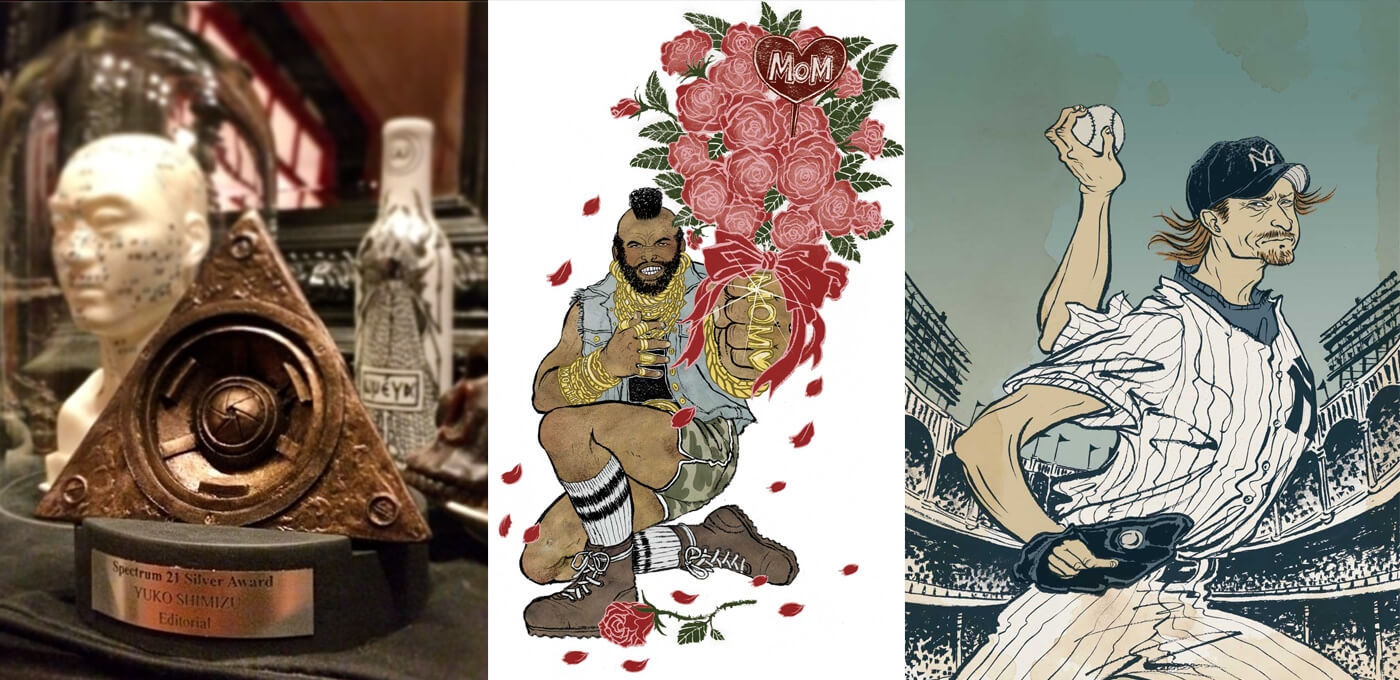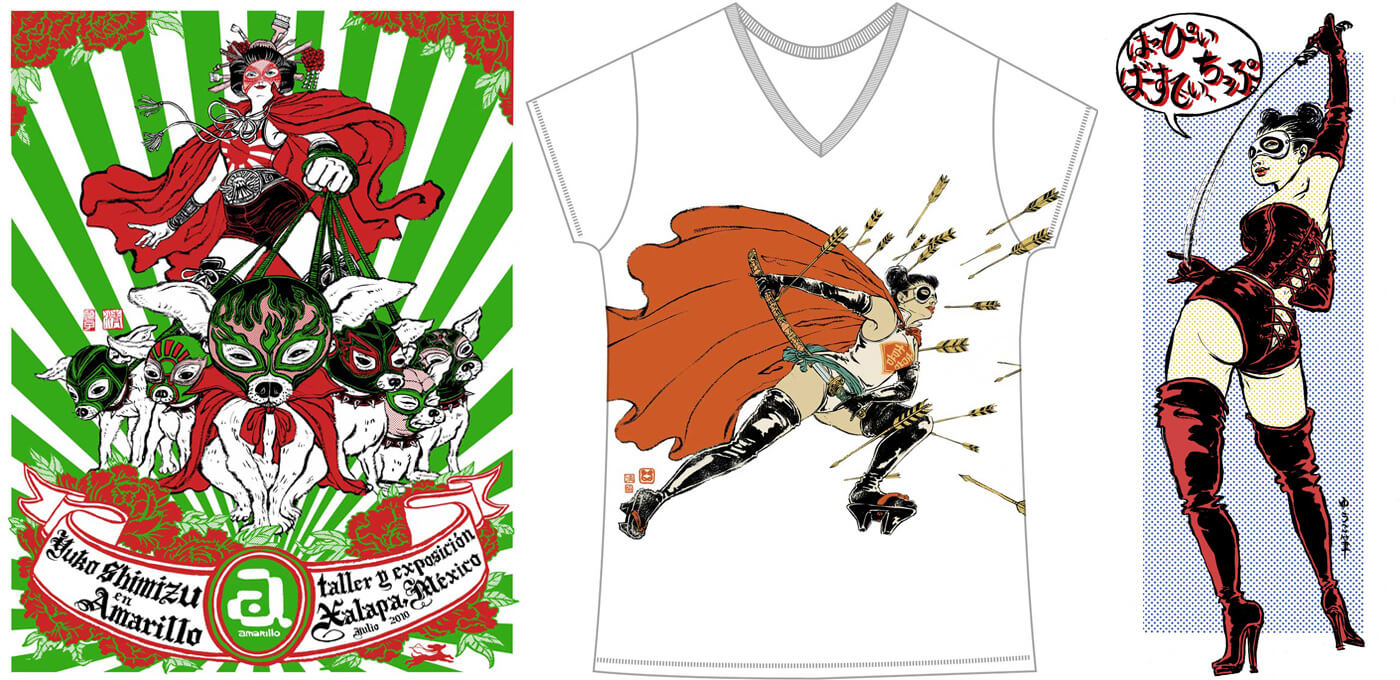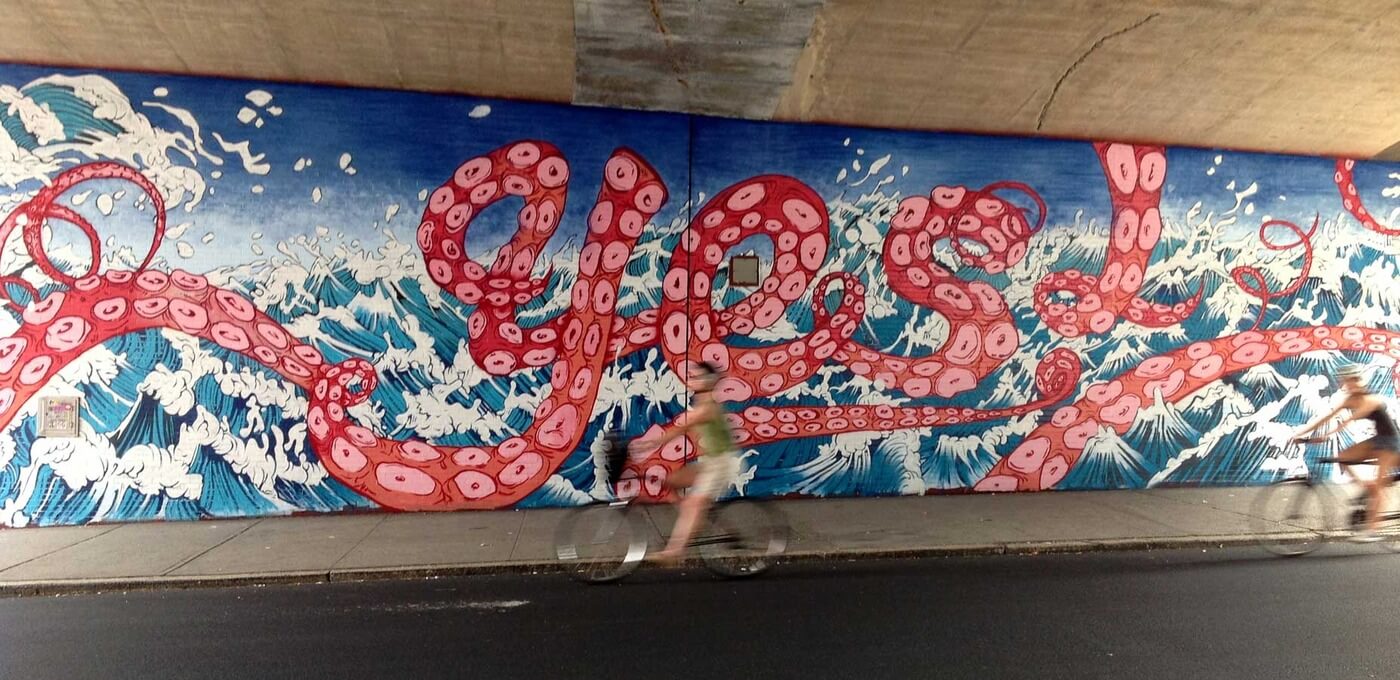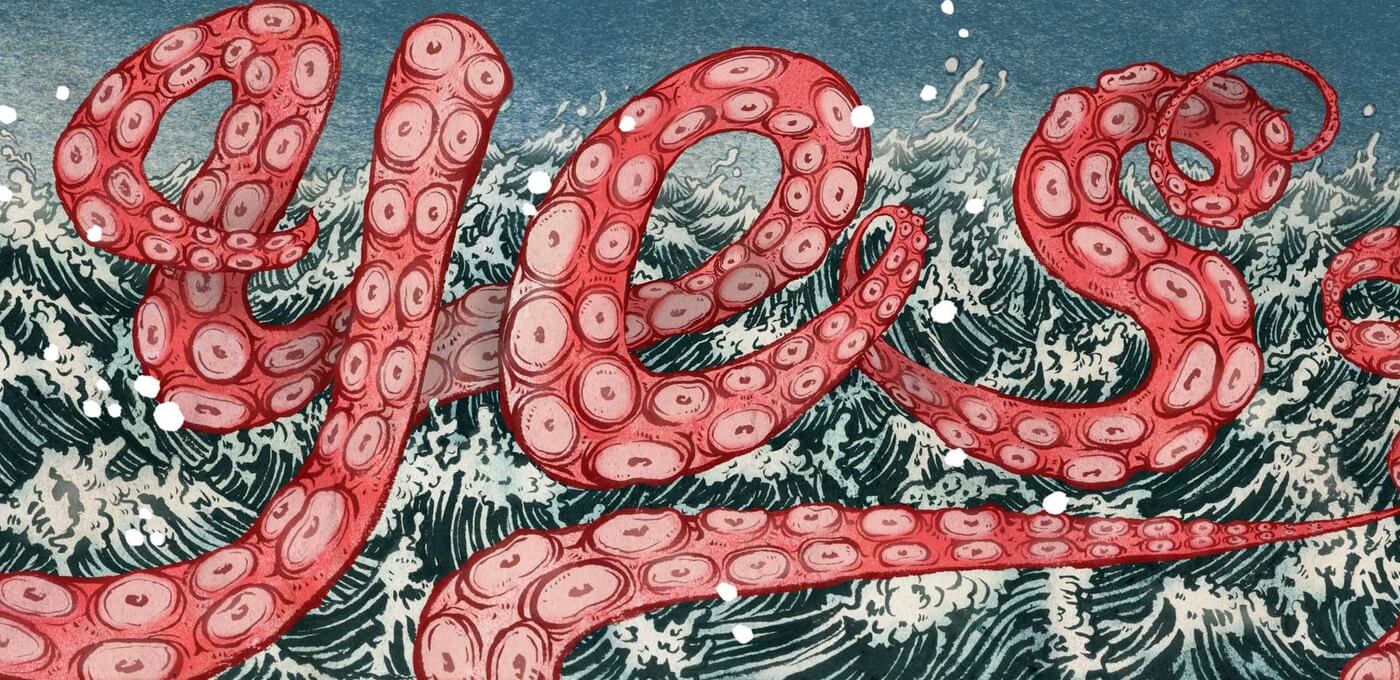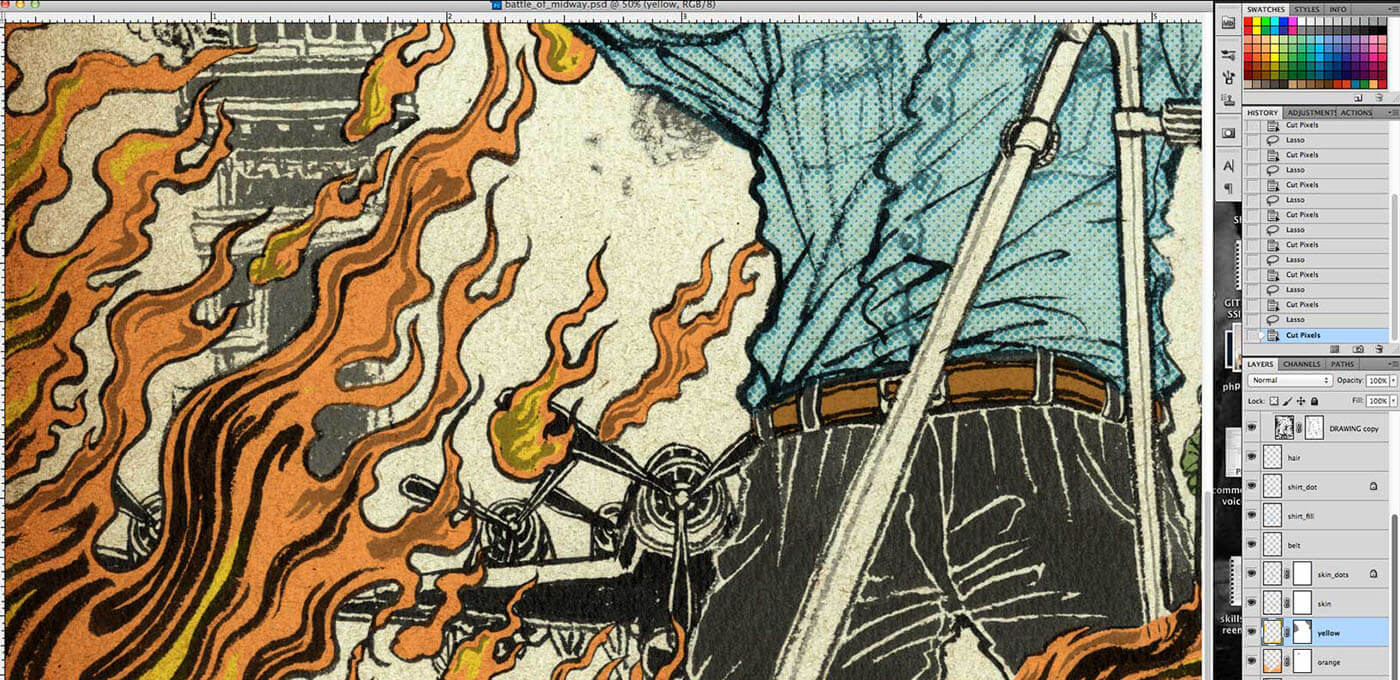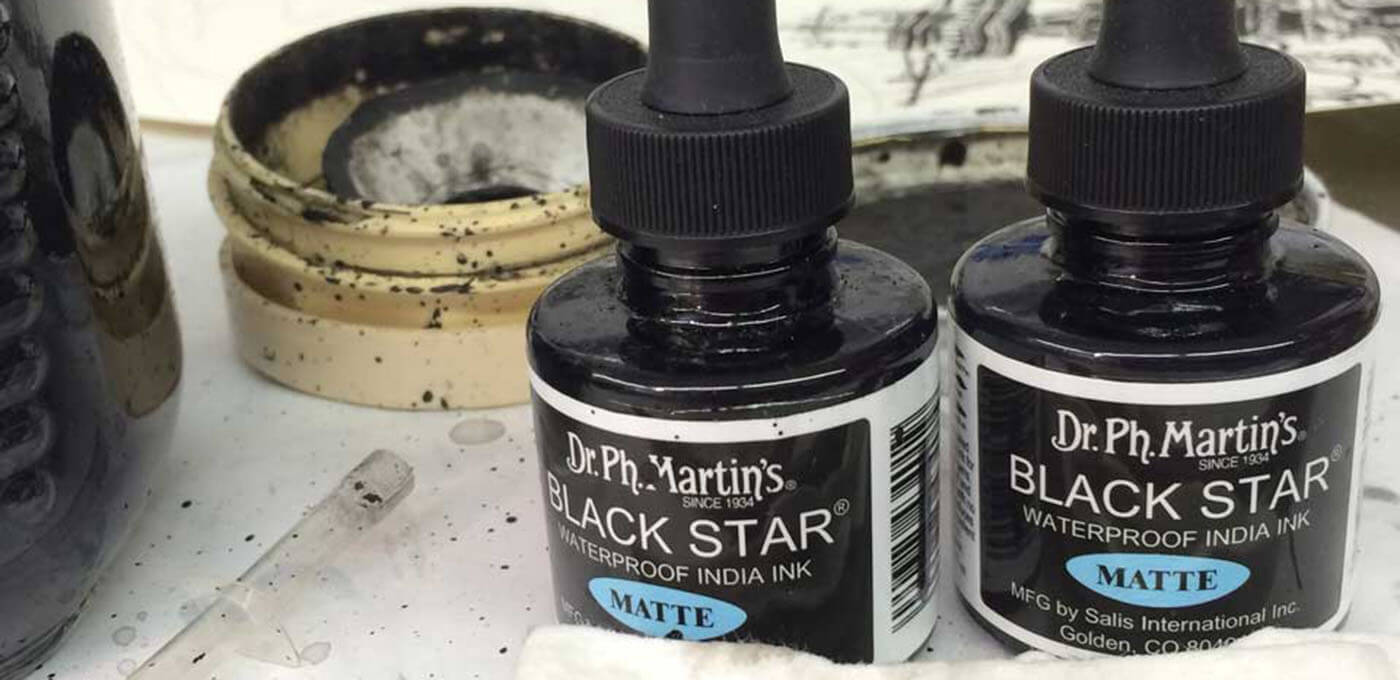Yuko Shimizu

2014-07-31
A talk with an illustrator who followed her passion to become one of the best.
I first met Yuko Shimizu while presenting at the FITC conference in Toronto. At Metajive we rarely use illustrators in our work but respect the humanity and variety of styles it can bring to design. I caught Yuko’s presentation and was immediately intrigued not only with her unique illustration style but also her story of perseverance. While Yuko’s is a story of success through perseverance, her story is also a result of a genuine passion for what she does. I was fortunate enough to spend some time with her on a recent trip to New York and dig deeper in to this recipe for success.
- D.B.
For those who live amongst the world of illustrators, Yuko Shimizu needs no introduction. With accolades from The Art Directors Club to The Yellow Pencil Award and many Spectrum Fantastic Art Awards, she is one of the most celebrated of our era. If this is not your world you will most likely recognize her art, because Yuko has a distinctive style that manages to combine traditional Japanese art with surrealism and comic book culture that has graced the pages of DC Comics, The New Yorker and Newsweek and she has contributed to magazines from Rolling Stone to the New York Times as well as countless books. With a client list that rivals any top tier agency, Yuko is on speed dial for many of the world's most influential editors.
Although Newsweek Japan chose Yuko as one of the “100 Japanese People the World Respects”, she doesn’t place herself on any pedestal even if others might want to put her up there. Compassionate, honest and funny, Yuko is a delight to spend time with. Never complacent about where she is at, she is constantly driving to challenge herself in new areas to keep the fire burning under her.
A Japanese native, Yuko moved to New York in 1999 to pursue her creative dreams after a lengthy career in corporate PR and has never looked back. But, as with most great success stories, the journey was not a direct trajectory to the top but rather a result of sheer devotion, sacrifice and year round hard work. Yuko Shimizu is, undoubtedly, a warrior of the modern kind.
Dave: Let’s start with the basics…How long have you been illustrating for?
Yuko: 12 years now as a professional.
Dave: Was it a lifelong passion?
Yuko: Well, when I went to college I majored in advertising. I was so set on having a job in advertising that I stopped drawing. It wasn’t the art side of advertising either, it was business school for advertising. So I stopped, then I got a job in corporate PR and I didn’t draw for a while.
Dave: Did you like the job?
Yuko: I actually did like the job…. I am not going to go back to it, but it’s probably better than other jobs I could have gotten. But definitely not something I wanted to do for the rest of my life. When people ask me what I would do if I wasn’t illustrating, I tell people that I would probably make a good illustration agent, as I have the PR background. After watching Sex and the City I’d probably make a pretty good publicist too, but then, I don’t know, I might not like it enough… The worst part of it was working for the corporate world. I don’t do great in corporate environments: I like to be my own boss.
You can’t pick a boss, and I’ve had some terrible bosses in the past, and it’s hard when your ideas are right and you try to convince them and they don’t understand at all…. I can’t deal with the corporate politics.
Dave: But you managed to stay there there 11 years?
Yuko: Initially I was going to quit – from the first day. But it’s hard to quit a job with a steady paycheck…
Dave: How hard was it to make that jump to working for yourself?
Yuko: I didn’t really have the guts to commit to doing art. People say “Oh it’s unstable, you will starve. No one makes money in art”. My family is a pretty typical Japanese family: My father worked for a corporation and my mother stayed home and took care of the family, and there was no-one remotely working in the art and design business. The only artists they know are the horror stories of Van Gogh.
Dave: What you do is different to just art. With art you get to draw what you want for you and hopefully people find value in that. You are doing illustration for design and advertising clients so you draw what they want, right?
Yuko: Yes, but they come to me because they want what I do. It’s not like they come to me and ask me to copy a style on the Internet. There are some people who do that who are happy to copy other people’s work styles or do what people ask them to do. I think there are 2 different types of illustrators, and 2 types of creatives in general. Either do something you are told to do or create something only you can give them.
So yes, it’s not art in the fine art sense, but I like illustration because it is in between art and the corporate world. I am more interested in working with clients and art directors who give me a brief and ask me what I come up with. But I work with them and create something together. I do like working with a team and clients and coming up with something together.
I AM MORE INTERESTED IN WORKING WITH CLIENTS AND ART DIRECTORS WHO GIVE ME A BRIEF AND ASK ME WHAT I COME UP WITH. BUT I WORK WITH THEM AND CREATE SOMETHING TOGETHER. I DO LIKE WORKING WITH A TEAM AND CLIENTS AND COMING UP WITH SOMETHING TOGETHER.

Dave: Would you say you have a specific illustration style where people can look at a poster and know its you?
Yuko: I don’t like the word style, as it sounds very superficial. But technically, yes, I do try to create something that when people see it without my name attached, they will see that that is Yuko’s – that’s what I am aiming for. So if a client comes to me, I will sometimes tell them that that’s not a good match for me, even if it’s a great client. So they should work with someone else who works with the style they are looking for.
Dave: Did you aspire to have a certain style? Was there something you wanted to come out?

Yuko: I think in illustration, you have to start with a certain style, even if it’s not as concrete as it will be 10 years later on. There are a gazillion people who can draw and illustrate; you really have to stand out to get work. But then also, in your first jobs you are still learning, so if you draw every day for 12 years professionally you do get better. I think I did aspire to certain illustrators at the beginning. A few years in I had to stop looking at other illustrators, because if you want to be like them at that point, the best you can be is second best.
A FEW YEARS IN I HAD TO STOP LOOKING AT OTHER ILLUSTRATORS, BECAUSE IF YOU WANT TO BE LIKE THEM AT THAT POINT, THE BEST YOU CAN BE IS SECOND BEST.
I think it’s a common trend across designers, photographers and artists in general, that when you are young you want to be like a certain person, but then there is a shift to where take your own path, but they helped you get where you wanted to go.

Dave: Would you say that turning down clients when you can see that you won’t do your best job for them has helped you on your career trajectory?
Yuko: I think so. There are career goals that people set up. For some people it’s making the maximum amount of money, so then you take every job… My ultimate goal is to be respected by peers and people I respect. In order to achieve that I probably make less money than those people whose goal it is to purely make money because I do turn down jobs because my work isn’t suitable for everything. There are people who do work that is a lot more suitable for a lot more things. Mine is kind of specific, so if the job doesn’t fit in the specific criteria they will call someone who does something a little more general. So it’s a decision you have to make.
It’s a hard thing to explain. It’s kind of like, being a pop star that sells lots of albums to everyone, or you being like Bjork…everyone knows what she does and she is probably a lot more respected than those pop stars who make a lot more money and are a lot more popular. I want to do work that I can be proud of, and something that people I respect would think that I am doing interesting things that are unique and different.
Dave: Whom did you look up to specifically in illustration?
Yuko: I studied illustration for 4 years but before that I knew nothing about it. I picked it because it is a good in-between art and commerce. There were people I looked up to but not obsessed over, because the period was so short. I wasn’t young when I started! I went to the School of Visual Arts in New York and that’s where I teach too now.

Dave: Why do you teach?
Yuko: I started teaching right after I got out of graduate school and Let’s be honest, it’s kind of cool to get invited back to teach. I never thought I would teach, I didn’t think I would like to do that. I have ups and downs and sometimes you have great classes and sometimes not, but after 6 or 7 years of teaching I kind of got it, and learned how to connect with students. I’ve learned how to tell them what’s not good and how to get better. And I’m not that young anymore and it’s really good to stay close to people who are just about to start working, They know a lot of things I don’t know like popular culture. Sometimes they tell me but just by looking at group dynamics each year I learn a lot. Illustration is a very lonely business – it’s just one person and I can come here (to the office) and not talk to anyone if I choose for days. It’s not good – you need communication with the outside world. It’s good to go to school and talk to 19 year olds and see what they have to say. It’s very interesting.
Dave: What are some of the great experiences you have had from being an illustrator?
Yuko: The coolest thing is that I got to work with Stefan Sagmeister. He emailed me. He doesn’t act how you think the top person in the design world would act. He is so down to earth! The first time he emailed me it was something like “ Hi, I’m Stefan Sagmeister. I’m a designer and you may not know my work but…” How could you not know his work?! When you meet those people who are at the top of their field and have been there so long, you kind of see why they are at the top of the game. It’s not just because their designs are so amazing, but usually their personalities are not how you think they would be.

Dave: I feel like when you are coming up, you feel like everyone is your competitor, but as you get higher up, you feel like you are on the same page with your peers. You get more comfortable and know there is enough work for everyone. Would you agree?
Yuko: Yes – if you get a job you help them and vice versa, it’s all about the match and the style of work. I do get a bit uncomfortable when I see that people are obviously imitating my former studio mate or imitating me, but usually they grow out of it if they are good enough.
Dave: Was there something that clicked for you when you found your own thing?
Yuko: I grew up with comics etc. and that was booming then, so it wasn’t that I tried to do what other people were doing but I drew that way and I was looking at people who were starting out and I realized you could get illustration jobs drawing that way. So in that sense I did follow a few other people like Tomer Hanuka who was already working a few years before me, and my class mate Nathan Fox was also doing a similar type of direction. We are in the same group, the 3 of us. They started earlier. Tomer started something very innovative. I rode the wave.

I STARTED GETTING EMAILS SAYING “I AM DOING THE SAME KIND OF THING, AND I AM NOT GETTING JOBS, HOW ARE YOU GETTING JOBS?” THAT’S WHEN I REALIZED THAT I WANTED TO LEAD AND NOT FOLLOW.
I started getting emails saying “I am doing the same kind of thing, and I am not getting jobs, how are you getting jobs?” That’s when I realized that I wanted to lead and not follow. It’s easy to follow in the bunch, a group of people who have the same look. That’s when I really started experimenting with different coloring techniques and inking techniques without changing what I like to do but experimenting a lot more.
I used to work with the Financial Times magazine in England and the budget wasn’t high and the timeline was tight so they let me experiment there. Once that almost once weekly job ended, I felt like I had moved out of that bunch of people. But it wasn’t that intentional at that point. I was “thank you!” every time I got a job. I didn’t turn away any jobs at that time. When you start out you need to think about keeping your monthly bills low… my studio rent was only $300 a month back then! The job let me pay my bills and experiment.
Dave: Do you have any advice for someone coming in to this?
Yuko: It’s so broad! I have too many things to say! Set your goals and have high ambition and work harder than your ambition. Love what you do because if you don’t…
Free-lancing sounds like a good life to people who aren’t doing it but it’s not that easy. It’s not a stable life, and there can be a lot of worries at times. The first 2 or 3 years of my career I worked 365 days a year. I really wanted to make it and my work to be known. I didn’t mind then and you kind of have to have that attitude of willing to work non-stop, especially at the beginning.

THE FIRST 2 OR 3 YEARS OF MY CAREER I WORKED 365 DAYS A YEAR. I REALLY WANTED TO MAKE IT AND MY WORK TO BE KNOWN. I DIDN’T MIND THEN AND YOU KIND OF HAVE TO HAVE THAT ATTITUDE OF WILLING TO WORK NON-STOP, ESPECIALLY AT THE BEGINNING.
Dave: Do you miss that level of ambition?
Yuko: I do and I don’t. Tell me to do it today and I’d say hell no! It’s like a life cycle – puppies are hyper and then they grow up, it’s like that too. If you can’t do it in the first few years, then you are in the wrong business!
Everything I do, I try to do something in it that I don’t know how to do and solve it. It’s really stressful and sometimes I want to quit, but then after I am done I feel good about accomplishing it. Every once in a while I have to throw in things I am not used to, so it’s kind of like that time when you are straight out of school and learning so much.
ONCE YOU REACH A CERTAIN TIME IN YOUR CAREER YOU DON’T HAVE ANYONE TO LOOK UP TO ANYMORE. YOU LOOK UP TO YOUR PEERS, BUT YOU KIND OF HAVE TO DO YOUR OWN THING THAT NO ONE ELSE HAS DONE.
Dave: What are the challenges ahead for you?
Yuko: I’m going to be starting a new project that will be taking a lot of my time. It’s a book project, but not a kid’s book. Something like that excites me as there are a lot of unknowns. It’s a collaboration with a writer, so it’s exciting and scary. I would like to try to do more longer-term projects. Like the mural with Stefan -- I had to really figure out how to make it work on an 80-foot wall…

Dave: Do you have goals remaining for working with certain publications or people?
Yuko: I did have a dream client list earlier on in my career, but I kind of threw that away eventually. I used to have a lot of clients like Stefan Sagmeister and Newsweek on the list and then you can check them off. But as time goes on you have to relax a bit and let the younger people do that, and you just try out different things.
At the beginning stage you kind of have to chase after people, but things get easier as your work is seen more. My motto is to not ask people. If you ask and they don’t want you it’s awkward. If they want you they will ask and if they don’t it’s ok!
Dave: But Is there anyone you would kill to work for?
Yuko: Bjork?!
Dave: Bjork, I am asking you to give Yuko and Bruiser a call.

Portraits by: Anton Repponen
Like what you saw?
Additional Insights
Interviews

Interviews

